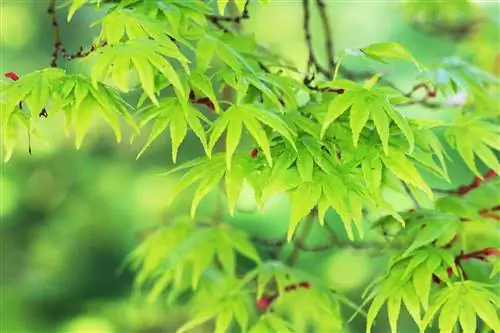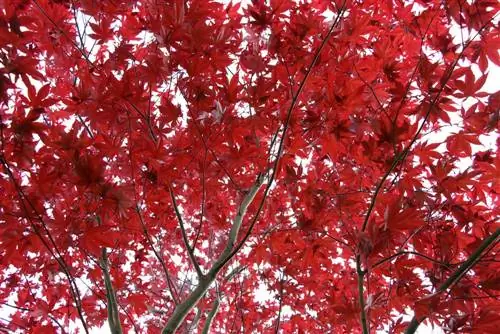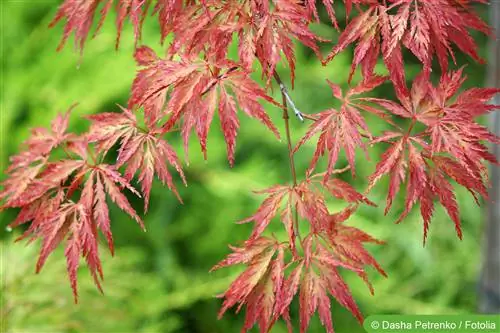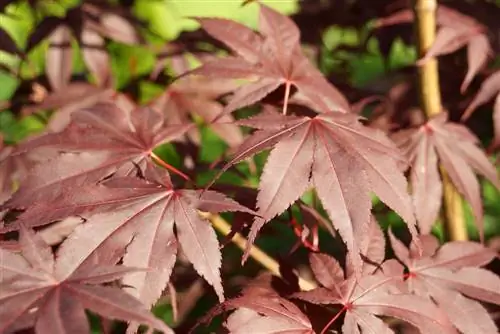- Author admin [email protected].
- Public 2023-12-17 03:39.
- Last modified 2025-01-24 12:45.
The Japanese maple is a popular ornamental tree because of its impressive autumn color. It is mandatory in a Japanese-style garden. There is a risk of confusion with Acer japonicum (Japanese maple), a close relative of the Japanese maple.
Profile
- Botanical name: Acer palmatum
- Common names: Slotted maple; occasionally red Japanese maple, incorrectly Japanese Japanese maple
- Plant family: Sapindaceae
- Leaves: up to 20 centimeters long, lobed or slit, often with colorful shoots, autumn color
- Growth habit: bushy, as a shrub or tree
- Growth height: 100 to 500 centimeters (depending on variety)
- Growth width: 50 to 300 centimeters (depending on variety)
- Flowering: inconspicuous, May to June
- Poisonous: no
- Use: Ornamental trees
Location
Whether the Japanese maple develops green or colored leaves depends on the variety. However, its impressive autumn color is influenced by the location. That's why you should have it on a
- sunny
- sheltered from the wind
Plant location. A partially shaded spot is tolerated, but at the expense of autumn color. Regardless of the lighting conditions, the microclimate should be favorable, as late frosts can damage the shoots.
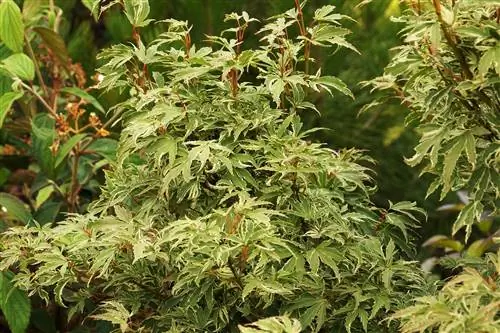
Soil / Substrate
Since Acer palmatum does not tolerate waterlogging at all, the soil should definitely
- easy,
- permeable
- be humorous.
Heavy, compacted or wet soil is a death sentence for Japanese maples. Sandy, humus-rich loamy soils are ideal. The pH value should be slightly acidic (low in lime) and be in the range 4.5 to 7. Slightly alkaline soil is also possible.
Tip:
You can improve pure sandy soils with plenty of humus. Since the Japanese maple suffers from a lack of water very quickly under these soil conditions, you should plant it in a slightly shady location.
Bucket Culture
When keeping them in a bucket, waterlogging must be avoided at all costs. That's why you should only use permeable substrate for potted plants. To ensure that the potted plant soil does not lose this property, you should mix in clay granules or expanded clay.
Plant Neighbors
Late-flowering perennials (monkshood, autumn crocus), ornamental grasses or autumn colors such as plumes or hazel go well with Acer palmatum as a solitary plant. It is often used as a companion plant for rhododendrons. In a group, the autumnal play of colors comes into its own even better if you combine varieties with red and (yellow-)orange autumn colors.
Plants
Late spring is the best time for planting in the garden. It is important that the ground is already a little warmer and no late frosts are expected. Proceed as follows:
- Dig planting hole
- Depth: Pot ball protrudes two centimeters, must not be covered with soil
- Insert plant in the middle
- Enrich the excavation with a generous portion of mature compost
- fill up
- Take on Earth easily
- pour heavily
- sprinkle a few handfuls of horn shavings under the plant
- Cover the root area with a layer of bark mulch
Tip:
Sandy and loamy soils should be loosened to a depth of 30 to 50 centimeters (=2 spade blades) over an area of around four square meters. (shallow roots)

Bucket Culture
- Pot size: at least 20 liters
- only use containers with a drain hole
- Create drainage made of gravel or pottery shards at the bottom of the pot
- Add a layer of potting soil on top
- Insert plant in the middle
- fill and pour
Repotting / Transplanting
If the Japanese maple has to give up its location, then you should move it when it is young. From the age of four, he doesn't like changing locations at all. In addition, its roots have spread so much that digging up and digging in is extremely difficult.
Bucket Culture
When kept in a pot, Acer palmatum occasionally needs a larger planter. However, you should not repot it too often. As a rule, it is sufficient if you move it to a larger container every three to five years, depending on its growth rate.
Pouring
Since the Japanese maple, as a shallow-rooted tree, does not reach deeper layers of the earth, freshly planted and young specimens need additional watering. Therefore, you should water these Japanese maples abundantly in summer and during warm and dry periods. Older plants that already have a widely branched root system are self-sufficient when it comes to water. Watering is only necessary if there is persistent drought.
Bucket Culture
Japanese maples kept in pots must be watered regularly as the roots cannot spread indefinitely. From September you should reduce watering so that the new wood can mature and Acer palmatum shows its impressive autumn colors.
Fertilize
Since Japanese maples do not have a high nutrient requirement, the motto when fertilizing is “Less is more!” You should also be careful because the roots run relatively close to the surface of the earth.
Note:
If the Japanese maple receives too much fertilizer, this will affect the autumn color of the leaves. It also loses winter hardiness.
Fertilizing planted specimens
- Mix in compost when planting (fertilizing is not necessary in the first year)
- apply liquid maple fertilizer from the second year onwards
- add to irrigation water every three to four weeks from April to August
Alternatively, you can scatter horn shavings or a mixture of mature compost and horn shavings in the root area of the Japanese maple annually in spring or autumn. Fertilizing is generally recommended in the first few years after planting, as the additional nutrients accelerate growth.
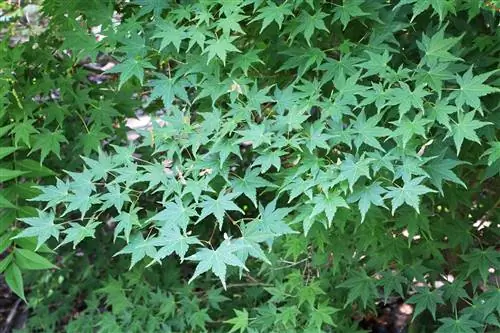
Fertilizing potted plants
- from April to mid-August
- once a month
- commercial liquid fertilizer is sufficient
Cutting
There are different philosophies about the pruning tolerance of Japanese maples. While some people actually warn against cutting, others refer to the Atropurpureum variety as bonsai culture, which requires regular cutting. However, since Acer palmatum naturally forms a beautiful crown and does not tend to age, pruning is hardly necessary.
If you need to prune the plant, you should do so at the end of the growing season in August or late summer. Cut off the offending shoot at the base. You should avoid cutting back into older wood, as Japanese maples only sprout slowly and the crown will look disfigured for a long time.
Note:
Acer palmatum should survive removing dead, dried or damaged branches without further damage. When making these corrections, be careful not to cut into the old wood.
Winter hardiness / overwintering
Acer palmatum is considered sufficiently frost hardy for the German winter. Temperatures down to -20 degrees Celsius (WHZ 6) are no problem for planted Japanese maples. When grown in containers, you should protect it from cold easterly winds and moisture. In harsh locations, additional winter protection is recommended.
Propagate
Propagate Acer palmatum is possible. However, neither growing with seeds nor with cuttings is considered practical for hobby gardeners. One problem with seed propagation is that only 20 percent even begin to germinate. In addition, this type of propagation is not varietal, so the offspring can differ significantly from the mother plant in terms of leaf and autumn color. Although cuttings are of the same variety, propagation is usually only possible in a greenhouse.
The prospects for home-grown Japanese maples are most successful if you sow seeds of the wild species:
- best time in March
- Put seeds in a box with sand in the refrigerator for a week before sowing (stratify)
- protect young seedlings from late frosts with fleece
- overwinter the first winter frost-free in the cold house
- only cultivate in the garden bed from the second year onwards
Note:
The different varieties in garden shops are usually grafted plants. The wild species of Acer palmatum serves as a seedling base for the scions.
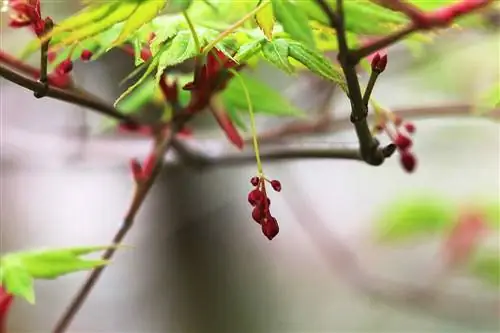
Diseases
The greatest danger to the Japanese maple isVerticillium wilt Since this fungal disease is incurable, the plant must be removed. We strongly advise against replanting in the same location as the soil is contaminated with the fungus. This penetrates the ducts via the roots and clogs them, blocking the supply of water and nutrients.
Typical symptoms are:
- dried, limp leaves
- dried shoots
- dying branches
Varieties
Atropurpureum
Acer palmatum Atropurpureum is the best-known cultivated form. It is also called red-leaved Japanese maple because of its purple-red leaves in summer and bright red autumn colors.
Fireglow
- Summer: bright velvet red
- Autumn color: orange-red
Orange Dream
- Summer: yellow-green
- Autumn color: orange-yellow
Oregon Sunset
- Summer: bright red
- Autumn color: red-violet
Moonfire
- Summer: dark purple-red
- Autumn color: bright deep red

